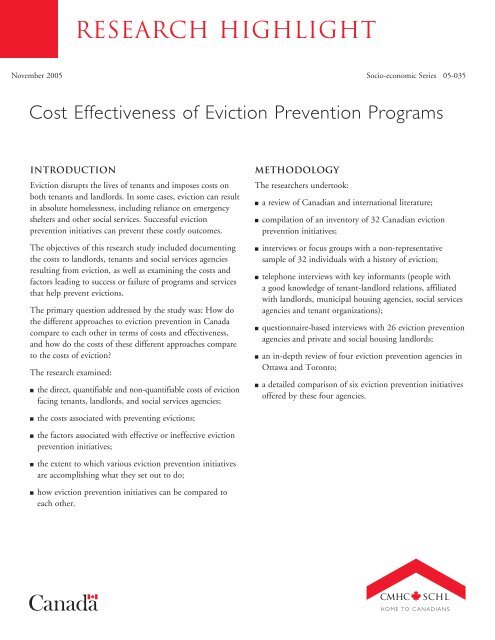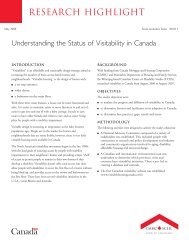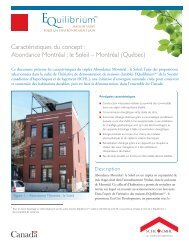Cost Effectiveness of Eviction Prevention Programs - SCHL
Cost Effectiveness of Eviction Prevention Programs - SCHL
Cost Effectiveness of Eviction Prevention Programs - SCHL
You also want an ePaper? Increase the reach of your titles
YUMPU automatically turns print PDFs into web optimized ePapers that Google loves.
November 2005<br />
Introduction<br />
<strong>Eviction</strong> disrupts the lives <strong>of</strong> tenants and imposes costs on<br />
both tenants and landlords. In some cases, eviction can result<br />
in absolute homelessness, including reliance on emergency<br />
shelters and other social services. Successful eviction<br />
prevention initiatives can prevent these costly outcomes.<br />
The objectives <strong>of</strong> this research study included documenting<br />
the costs to landlords, tenants and social services agencies<br />
resulting from eviction, as well as examining the costs and<br />
factors leading to success or failure <strong>of</strong> programs and services<br />
that help prevent evictions.<br />
The primary question addressed by the study was: How do<br />
the different approaches to eviction prevention in Canada<br />
compare to each other in terms <strong>of</strong> costs and effectiveness,<br />
and how do the costs <strong>of</strong> these different approaches compare<br />
to the costs <strong>of</strong> eviction?<br />
The research examined:<br />
research highlight<br />
■ the direct, quantifiable and non-quantifiable costs <strong>of</strong> eviction<br />
facing tenants, landlords, and social services agencies;<br />
■ the costs associated with preventing evictions;<br />
■ the factors associated with effective or ineffective eviction<br />
prevention initiatives;<br />
■ the extent to which various eviction prevention initiatives<br />
are accomplishing what they set out to do;<br />
■ how eviction prevention initiatives can be compared to<br />
each other.<br />
Methodology<br />
The researchers undertook:<br />
Socio-economic Series 05-035<br />
<strong>Cost</strong> <strong>Effectiveness</strong> <strong>of</strong> <strong>Eviction</strong> <strong>Prevention</strong> <strong>Programs</strong><br />
■ a review <strong>of</strong> Canadian and international literature;<br />
■ compilation <strong>of</strong> an inventory <strong>of</strong> 32 Canadian eviction<br />
prevention initiatives;<br />
■ interviews or focus groups with a non-representative<br />
sample <strong>of</strong> 32 individuals with a history <strong>of</strong> eviction;<br />
■ telephone interviews with key informants (people with<br />
a good knowledge <strong>of</strong> tenant-landlord relations, affiliated<br />
with landlords, municipal housing agencies, social services<br />
agencies and tenant organizations);<br />
■ questionnaire-based interviews with 26 eviction prevention<br />
agencies and private and social housing landlords;<br />
■ an in-depth review <strong>of</strong> four eviction prevention agencies in<br />
Ottawa and Toronto;<br />
■ a detailed comparison <strong>of</strong> six eviction prevention initiatives<br />
<strong>of</strong>fered by these four agencies.
Research Highlight<br />
<strong>Cost</strong> <strong>Effectiveness</strong> <strong>of</strong> <strong>Eviction</strong> <strong>Prevention</strong> <strong>Programs</strong><br />
Findings<br />
Literature review<br />
The literature suggests that in recent years many Canadian<br />
cities experienced some combination <strong>of</strong> rising rents, very limited<br />
new construction <strong>of</strong> rental housing, falling incomes among<br />
modest income families and individuals, and limited access to<br />
social housing. Combined with low vacancy rates, these factors<br />
created conditions for an increased number <strong>of</strong> evictions.<br />
The vast majority <strong>of</strong> evictions are economic in nature,<br />
involving some form <strong>of</strong> non-payment <strong>of</strong> rent. <strong>Eviction</strong>s<br />
occur in both private and social housing. A significant<br />
number <strong>of</strong> evictions are believed to be preventable, since<br />
many are caused by misunderstandings or a temporary lack<br />
<strong>of</strong> funds due to an unexpected incident. Because few tenants<br />
seek assistance in opposing evictions, it is likely that eviction<br />
prevention initiatives could play an important role in<br />
maintaining stable housing for vulnerable households.<br />
An overview <strong>of</strong> literature from the US, UK, France and<br />
Australia revealed that, while there is considerable information<br />
on the types <strong>of</strong> eviction prevention initiatives which exist<br />
internationally, there is a lack <strong>of</strong> empirical evaluative<br />
information. Available information tends to be descriptive.<br />
<strong>Cost</strong>s to landlords and tenants <strong>of</strong>ten occur indirectly, and<br />
eviction prevention program budget details are <strong>of</strong>ten<br />
unclear, or buried within broader agency-wide budgets.<br />
2<br />
Canada Mortgage and Housing Corporation<br />
Numerous reports and studies from Canada, the US and<br />
UK establish an explicit link between eviction and absolute<br />
homelessness; hence, many eviction prevention initiatives<br />
claim to avert emergency shelter usage and the costs <strong>of</strong><br />
associated supportive services. However, lack <strong>of</strong> previous<br />
rigorous research on this topic makes it difficult to know<br />
to what extent eviction prevention initiatives actually<br />
contribute to complex and long-term outcomes that are<br />
cited in the literature, such as increased housing stability <strong>of</strong><br />
tenants, reduced reliance on publicly-funded social services,<br />
and rental affordability.<br />
Canadian eviction prevention initiatives<br />
This study presents an overview <strong>of</strong> 32 Canadian eviction<br />
prevention initiatives in five categories:<br />
■ 12 initiatives focused primarily on providing information<br />
and advice;<br />
■ five programs <strong>of</strong>fered conflict resolution and mediation<br />
services;<br />
■ one provided legal representation;<br />
■ 11 provided emergency financial assistance (including rent<br />
banks); and<br />
■ three <strong>of</strong>fered third-party financial management, or<br />
trusteeship-style programs.<br />
Publicly funded and administered, community-based and<br />
private initiatives were included. Most <strong>of</strong>fered services to<br />
any client who contacted them, while some targeted their<br />
services to particular populations. The median annual<br />
budget for programs included in the inventory was about<br />
$159,000, with reported annual budgets ranging from<br />
$25,000 to $10.4 million.
<strong>Cost</strong>s <strong>of</strong> eviction to tenants<br />
The survey <strong>of</strong> 32 individuals with a history <strong>of</strong> eviction<br />
(13 women and 19 men in Montréal, Ottawa and Vancouver)<br />
addressed the direct and indirect costs <strong>of</strong> eviction to tenants.<br />
Nine <strong>of</strong> the respondents were part <strong>of</strong> families, while 23 were<br />
single at the time <strong>of</strong> the survey. Fourteen <strong>of</strong> the 32 respondents<br />
reported being homeless at the time <strong>of</strong> the survey, while<br />
18 lived in rental accommodation.<br />
The costs most <strong>of</strong>ten reported by the individuals participating<br />
in the study were the loss <strong>of</strong> belongings, loss <strong>of</strong> security or<br />
damage deposits, and moving expenses. In addition, the<br />
costs <strong>of</strong> setting up a new residence and higher transportation<br />
costs were described as significant by a number <strong>of</strong> individuals.<br />
The average cost <strong>of</strong> each eviction to tenants in this sample<br />
was $2,234.<br />
Consistent with other research, this study found that<br />
eviction <strong>of</strong>ten resulted in tenants moving to less stable<br />
accommodation. After eviction, some respondents reported<br />
a loss <strong>of</strong> employment, and greater reliance on social<br />
assistance. Twenty-four <strong>of</strong> the 32 participants indicated that<br />
they lived in an emergency shelter at some point during the<br />
weeks following their eviction. Other common themes<br />
identified by respondents centered on social disruption<br />
including loss <strong>of</strong> friends and social networks, and family<br />
break-up. Substance abuse was common among evicted<br />
tenants in this sample, as were arrests <strong>of</strong> tenants by police in<br />
the weeks following eviction.<br />
Respondents described a number <strong>of</strong> barriers and difficulties<br />
related to securing new accommodation subsequent to being<br />
evicted. Private rental units were <strong>of</strong>ten described as too<br />
expensive and tenants were unable to secure social housing<br />
because <strong>of</strong> long waiting lists.<br />
Research Highlight<br />
<strong>Cost</strong> <strong>Effectiveness</strong> <strong>of</strong> <strong>Eviction</strong> <strong>Prevention</strong> <strong>Programs</strong><br />
<strong>Cost</strong>s <strong>of</strong> eviction to landlords<br />
Landlords participating in the study indicated that the costs<br />
<strong>of</strong> each eviction are substantial, averaging nearly $3,000 for<br />
social housing landlords, and close to $6,600 for private<br />
sector landlords. <strong>Cost</strong>s included legal fees, unpaid rent,<br />
foregone rent, and rental unit repairs. A number <strong>of</strong><br />
landlords reported budgeting for these costs or foregone<br />
revenues as operating costs or vacancy costs. Landlords also<br />
seek to recover costs from evicted tenants.<br />
Public costs <strong>of</strong> eviction<br />
Estimates <strong>of</strong> the public costs <strong>of</strong> eviction were based on a<br />
2001 report prepared for the Government <strong>of</strong> British<br />
Columbia which quantified per-capita costs <strong>of</strong> a wide range<br />
<strong>of</strong> publicly-funded services associated with homelessness.<br />
Based on these estimates, the study found it would have cost<br />
up to $2,500 to house those tenants who relied on an<br />
emergency shelter for a month following eviction. The cost<br />
<strong>of</strong> housing tenants who reported living in social housing<br />
would have been as much as $5,000 (for a self-contained<br />
apartment with supports on site). For tenants accessing<br />
addiction treatment, costs would have ranged from $2,000<br />
to $10,000 for a month, depending on the level <strong>of</strong> services.<br />
Canada Mortgage and Housing Corporation 3
Research Highlight<br />
<strong>Cost</strong> <strong>Effectiveness</strong> <strong>of</strong> <strong>Eviction</strong> <strong>Prevention</strong> <strong>Programs</strong><br />
Achieving eviction prevention<br />
The respondents to the survey <strong>of</strong> tenants with a history<br />
<strong>of</strong> eviction indicated that their landlords had tried to evict<br />
them an average <strong>of</strong> 2.9 times, while they had actually<br />
vacated their rental units an average <strong>of</strong> 2.1 times. The<br />
range <strong>of</strong> responses included one tenant who had been<br />
evicted 11 times based on 12 attempts by different<br />
landlords, to another who had never been actually evicted<br />
despite receiving six separate notices <strong>of</strong> eviction. While<br />
approximately one-third <strong>of</strong> interviewed tenants facing an<br />
eviction had taken no action, the majority <strong>of</strong> participants<br />
made efforts to challenge their eviction. Many reported<br />
engaging in discussion with landlords and seeking<br />
information, while a few reported seeking third-party<br />
or financial assistance. Most efforts to prevent eviction<br />
had been unsuccessful, with only seven <strong>of</strong> the 32 tenants<br />
reporting that they had successfully prevented at least one<br />
eviction. Tenants unable to prevent their eviction cited<br />
several limitations <strong>of</strong> available programs. They suggested<br />
that administrative procedures <strong>of</strong>ten were not a good fit with<br />
tenant circumstances or needs. Tenants facing both eviction<br />
and other problems such as addiction, abuse, and lack <strong>of</strong><br />
knowledge <strong>of</strong> landlord-tenant laws expressed feelings <strong>of</strong><br />
helplessness as supports which were available to them did<br />
not address their multiple and interconnecting difficulties.<br />
4<br />
Canada Mortgage and Housing Corporation<br />
Landlord assessments <strong>of</strong> successful eviction prevention<br />
initiatives varied considerably. Financial trusteeship, rent<br />
subsidies, and emergency financial assistance were rated most<br />
favourably. Information and legal representation for tenants<br />
were viewed by landlords as least effective.<br />
<strong>Eviction</strong> prevention agencies generally felt that their efforts<br />
were successful. Agencies identified outreach, direct contact<br />
with landlords, multiple approaches and timing as central<br />
to their successes. Program location was not considered to<br />
be <strong>of</strong> high importance. In addition, several programs cited<br />
adequacy <strong>of</strong> resources, and political and economic factors<br />
as significant determinants <strong>of</strong> program success.<br />
Comparing costs and effectiveness <strong>of</strong><br />
preventing eviction<br />
Detailed comparison <strong>of</strong> eviction prevention programs is<br />
difficult, both because <strong>of</strong> the tremendously wide variation in<br />
programs and the challenges <strong>of</strong> long-term tracking <strong>of</strong> clients.<br />
In this study, six eviction prevention programs delivered by<br />
four agencies in Ottawa and Toronto were compared as to<br />
cost and effectiveness. Each initiative was categorized as<br />
high, medium, or low cost, and assessed in terms <strong>of</strong> ‘reach’<br />
(number <strong>of</strong> clients contacted), extent to which services are<br />
targeted to particular clients, and service impact in terms <strong>of</strong><br />
client housing retention (see Table 1). Per-client costs <strong>of</strong><br />
these six initiatives ranged from $106 to $2,088.
Table 1 Comparing costs and effectiveness <strong>of</strong> preventing eviction<br />
Agency Initiative Annual cost<br />
per client<br />
Advocacy Centre for<br />
Tenants Ontario (ACTO)<br />
Neighbourhood<br />
Information Post (NIP)<br />
Neighbourhood<br />
Information Post (NIP)<br />
<strong>Effectiveness</strong> (reach, targetting, impact)<br />
Research Highlight<br />
<strong>Cost</strong> <strong>Effectiveness</strong> <strong>of</strong> <strong>Eviction</strong> <strong>Prevention</strong> <strong>Programs</strong><br />
Tenant Duty Counsel $106 (low) Very wide reach (6,000 people over 6 months)<br />
Moderately effective targeting<br />
Low, limited impact (eviction typically delayed rather than prevented)<br />
Toronto Rent Bank $1709 (high) Moderate reach<br />
Moderately effective targetting (families at risk <strong>of</strong> eviction)<br />
High medium-term impact (87% <strong>of</strong> clients avoided eviction for 7 months)<br />
Trusteeship program $706 (medium) Limited reach (36 clients served)<br />
Highly effective targetting (all clients at high risk <strong>of</strong> eviction and absolute<br />
homelessness)<br />
High long-term impact (94% <strong>of</strong> clients remained permanently housed)<br />
Salvation Army HomeSafe Rent Bank $1085 (high) Moderate reach<br />
Moderately effective targetting (families at risk <strong>of</strong> eviction)<br />
Potentially high medium-term impact (94% <strong>of</strong> tracked clients still in housing<br />
after 6 months, but 64% <strong>of</strong> client outcomes unknown)<br />
Salvation Army MoneyWise<br />
Trusteeship<br />
Pinecrest-Queensway Health<br />
and Community Services<br />
Conclusions<br />
Housing Loss<br />
<strong>Prevention</strong> Network<br />
The costs <strong>of</strong> eviction are substantial, affecting tenants,<br />
landlords and the taxpayer. Tenants also experience difficultto-quantify<br />
social and other costs as a result <strong>of</strong> eviction.<br />
The costs <strong>of</strong> prevention vary significantly, depending on<br />
the type <strong>of</strong> intervention. In general, preventing evictions<br />
costs far less than the costs <strong>of</strong> eviction incurred by tenants<br />
and landlords. However, comparing the cost <strong>of</strong> eviction<br />
prevention programs to the costs incurred by government<br />
and community services when evictions occur is difficult,<br />
since an unknown percentage <strong>of</strong> evicted households relies<br />
on publicly-funded services.<br />
$2088 (high) Limited reach (76 clients in 2003)<br />
Highly effective targetting (all clients at high risk <strong>of</strong> eviction and absolute<br />
homelessness)<br />
High long-term impact (93% <strong>of</strong> clients retained housing for at least 1 year)<br />
$377 (medium) Wide reach (661 clients in first 9 months <strong>of</strong> 2004)<br />
Effective targetting (clients face imminent loss <strong>of</strong> housing)<br />
High long-term impact (95% <strong>of</strong> clients retained their housing)<br />
The top success factors in preventing evictions identified by<br />
agency survey respondents included direct outreach, early<br />
intervention, and <strong>of</strong>fering multiple and complementary<br />
services. Landlords preferred programs which rely on<br />
payments made directly to landlords from agencies<br />
delivering eviction prevention programs.<br />
More evaluations and more thorough evaluations <strong>of</strong><br />
programs would be useful in order to ascertain whether they<br />
are accomplishing their goals. Available reports tend to focus<br />
on numbers <strong>of</strong> clients served rather than tracking the impact<br />
<strong>of</strong> the program. Evaluations were available for the six programs<br />
selected for more careful analysis during the course <strong>of</strong> the<br />
study. Based on available data, these six programs appear to<br />
be accomplishing their goals.<br />
Canada Mortgage and Housing Corporation 5
64906<br />
Research Highlight<br />
<strong>Cost</strong> <strong>Effectiveness</strong> <strong>of</strong> <strong>Eviction</strong> <strong>Prevention</strong> <strong>Programs</strong><br />
CMHC Project Manager: Anna Lenk<br />
Consultant: Acacia Consulting & Research<br />
Housing Research at CMHC<br />
Under Part IX <strong>of</strong> the National Housing Act, the Government<br />
<strong>of</strong> Canada provides funds to CMHC to conduct research into<br />
the social, economic and technical aspects <strong>of</strong> housing and related<br />
fields, and to undertake the publishing and distribution <strong>of</strong> the<br />
results <strong>of</strong> this research.<br />
This fact sheet is one <strong>of</strong> a series intended to inform you <strong>of</strong> the<br />
nature and scope <strong>of</strong> CMHC’s research.<br />
To find more Research Highlights plus a wide variety <strong>of</strong><br />
information products, visit our website at<br />
www.cmhc.ca<br />
or contact:<br />
Canada Mortgage and Housing Corporation<br />
700 Montreal Road<br />
Ottawa, Ontario<br />
K1A 0P7<br />
Phone: 1-800-668-2642<br />
Fax: 1-800-245-9274<br />
©2005, Canada Mortgage and Housing Corporation<br />
Printed in Canada<br />
Produced by CMHC 01-12-09<br />
Revised: 2009<br />
Although this information product reflects housing experts’ current knowledge, it is provided for general information purposes only. Any reliance<br />
or action taken based on the information, materials and techniques described are the responsibility <strong>of</strong> the user. Readers are advised to consult<br />
appropriate pr<strong>of</strong>essional resources to determine what is safe and suitable in their particular case. Canada Mortgage and Housing Corporation<br />
assumes no responsibility for any consequence arising from use <strong>of</strong> the information, materials and techniques described.

















